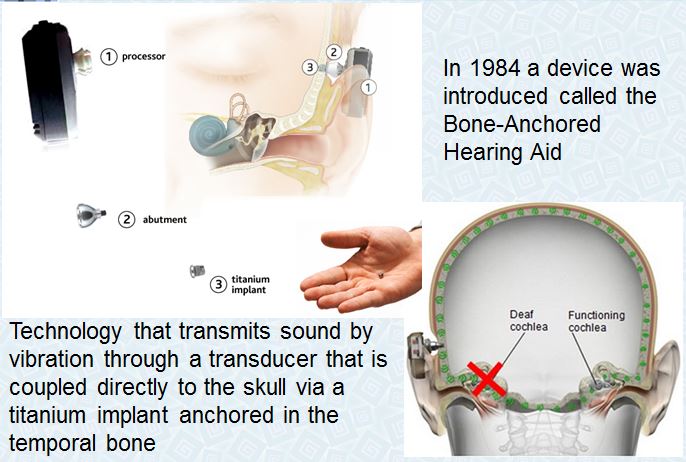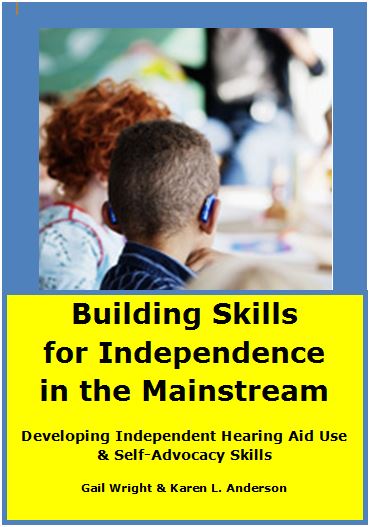Related Products
For Professionals
- Amplification
- Assessment of Student Skills, Challenges, Needs
- Early Childhood: Infants, Toddlers, Preschool
- Hearing Loss – Identification, Impact and Next Steps
- IDEA Law Summary Information
- Language and Speech Development Issues
- Legal Issues in Serving Children with Hearing Loss
- Listening (Auditory Skills) Development
- Planning to Meet Student Needs
- Self-Advocacy Skills for Students with Hearing Loss
- Self-Concept: How the Child with Hearing Loss Sees Himself
- Social Skills
- Speech Perception & Learning
Related Teacher Tools Takeout Items
Bone-Anchored Hearing Solutions
A bone-anchored hearing aid (BAHA) or bone-anchored hearing device, is a type of hearing aid based on bone conduction. Candidates for bone anchored amplification options include children with outer and/or middle ear deformities causing significant longstanding conductive hearing loss or children who have singled-sided deafness.
How it works to help people hear better: Bone-anchored hearing aids use a surgically implanted abutment to transmit sound by direct conduction through bone to the inner ear, bypassing the external auditory canal and middle ear. A sound processor attached to the abutment will transmit the sound by direct conduction through bone to the inner ear, bypassing the external auditory canal and middle ear. The implant vibrates the skull and inner ear, which stimulate the hair cells of the inner ear, allowing hearing.
Candidates for Bone-Anchored Hearing Solutions
Outer ear malformations: A child born without external ear canals does not have the option of using a conventional hearing aid with an earmold in the ear canal opening. Some children with absent or malformed outer ears have normal inner ear function, as the external ear canal and the inner ear are developed at different stages during pregnancy. With normal inner anatomy, sound conducted by the skull bone improves hearing.
 Chronic conductive hearing loss: Children with chronic ear infection where the drum and/or the small bones in the middle ear are damaged often have hearing loss, but difficulties with hearing loss fluctuation and openings in the eardrum can make use of a typical hearing aid challenging. More information about one type of potential candidate can be found on the Cholesteatoma web page. Direct bone conduction through a vibrator attached to a skin-penetrating implant addresses these disadvantages.
Chronic conductive hearing loss: Children with chronic ear infection where the drum and/or the small bones in the middle ear are damaged often have hearing loss, but difficulties with hearing loss fluctuation and openings in the eardrum can make use of a typical hearing aid challenging. More information about one type of potential candidate can be found on the Cholesteatoma web page. Direct bone conduction through a vibrator attached to a skin-penetrating implant addresses these disadvantages.
Single-sided deafness / unilateral hearing loss: A child with unilateral hearing loss will have functional difficulty hearing even when the other ear is normal, particularly in noisy environments and when several people are speaking the same time. Children with hearing loss in the range of 26-75 dB can use a conventional hearing aid on the affected ear. Those children with hearing loss of 80 dB or greater are considered to have single-sided deafness, and a conventional hearing aid will not restore any resemblance of balanced hearing between the two ears. Also, the hearing of persons with severe to profound hearing loss may be affected by a decrease in clarity (distortion) along with loudness so putting a hearing aid on the ‘deaf’ ear may introduce amplification of distorted hearing that can effect overall understanding, even if one ear is typically hearing. An extended trial of a bone-anchored hearing system with a headband prior to surgery is important to determine potential benefit and realistic expectations.
Surgery: Bone-anchored devices have an implant that is surgically placed in the bone. The implant is made of commercially pure titanium and will osseointegrate, or integrate effectively with bone behind the ear. A skin-penetrating coupling, called an abutment, is secured to the implant in the bone. An important piece of information for patients is that if they for whatever reason are not satisfied with the bone-anchored hearing solution, removing the implant is easy. No other surgical ear procedure is reversible like this.



